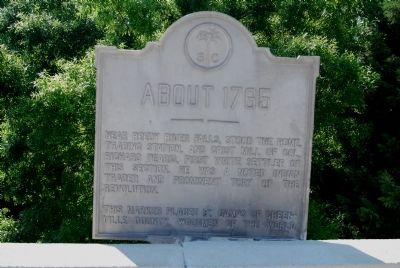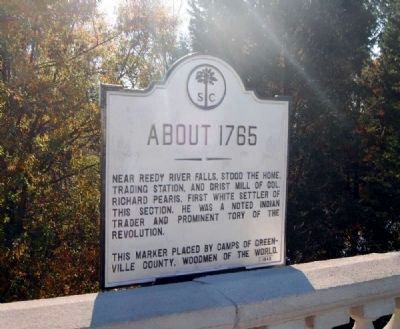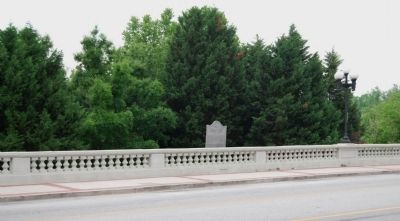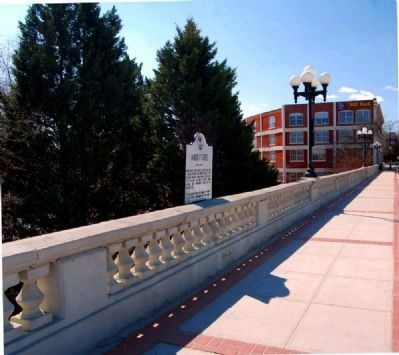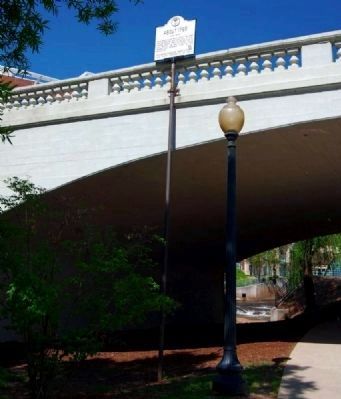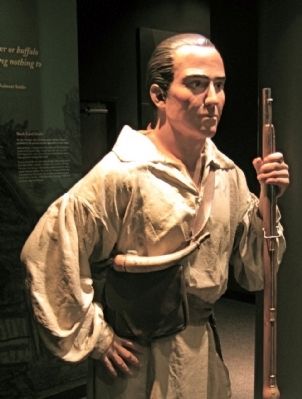Greenville in Greenville County, South Carolina — The American South (South Atlantic)
About 1765
Near Reedy River Falls, stood the home, trading station, and grist mill of Col. Richard Pearis, first white settler of this section. He was a noted Indian trader and prominent Tory of the Revolution.
Erected 1948 by Camps of Greenville County, Woodmen of the World. (Marker Number 23-4.)
Topics. This historical marker is listed in these topic lists: Colonial Era • Industry & Commerce • Native Americans • War, US Revolutionary. A significant historical year for this entry is 1765.
Location. 34° 50.761′ N, 82° 24.077′ W. Marker is in Greenville, South Carolina, in Greenville County. Marker is on South Main Street (State Highway 124), on the left when traveling south. Marker is located on the southeast side of the bridge crossing over the Reedy River. Touch for map. Marker is in this post office area: Greenville SC 29601, United States of America. Touch for directions.
Other nearby markers. At least 10 other markers are within walking distance of this marker. The "Swamp Rabbit" Railroad (a few steps from this marker); Thomas C. Gower Bridge (within shouting distance of this marker); Eugenia Duke Bridge (within shouting distance of this marker); Wyche Pavilion (within shouting distance of this marker); Vardry Dixon Ramseur, III (about 300 feet away, measured in a direct line); Falls Place (about 300 feet away); Welcome to Falls Park (about 300 feet away); Liberty Bridge (about 300 feet away); Buck Mickel (about 400 feet away); Dr. Charles Hard Townes (about 400 feet away). Touch for a list and map of all markers in Greenville.
Also see . . .
1. Richard Pearis. Wikipedia entry:
Richard Pearis (1725 – 1794) was an Indian trader, a pioneer settler of Upstate South Carolina, and a Loyalist officer during the American Revolution. (Submitted on February 2, 2009, by Brian Scott of Anderson, South Carolina.)
2. Falls Park on the Reedy. Wikipedia entry (Submitted on December 27, 2021, by Larry Gertner of New York, New York.)
3. American History: Greenville County, South Carolina. Electric Scotland website entry:
While the lower parts of South Carolina had been settled for many years, Greenville County remained part of the old Cherokee hunting grounds and white men were strictly forbidden to enter the area. (Submitted on February 3, 2009, by Brian Scott of Anderson, South Carolina.)
Additional commentary.
1. Richard Pearis
Richard Pearis was born in Ireland and settled in Frederick county, Virginia, before 1750. At the outbreak of the Revolutionary war he was a successful planter and Indian trader on the Enoree river in South Carolina.
An orator of rude, savage eloquence and power, he commended himself to Governor Dinwiddie by his loyalty and efficiency. He became lieutenant in the Virginia Provincial regiment in 1755 and was commissioned captain in 1756 to command a company of Cherokees and Catawbas in an expedition against the Shawnee towns west of the Ohio, under Major Andrew Lewis. Pearis served under Generals Forbes, Stanwix, Monckton, and Bouquet. He was the first to enter Fort Duquesne. His military ability was apparent in his services on the borders of Maryland, Pennsylvania, and Virginia, with headquarters at Fort Pitt.
Having married a Cherokee wife, Captain Pearis acquired great influence among the Indians, and was consequently ordered south. In 1768 he was settled at the Big Canebrake, on the Reedy river, South Carolina.
Every effort was made by the Whigs in 1775 to induce this powerful man and the Indians to join them, or at least to secure their neutrality. However, Pearis took part in the siege of Ninety- Six on the British side and many other actions.
In July, 1776, he was one of a party of 260 loyal militia and Indians which unsuccessfully attacked 450 "rebels" in a wooden fort.
According to his own narrative, his services to the crown in the same year include the dispersal of 700 "rebels" in the district of Ninety-Six. By the turn of fortune he was captured and consigned to Charleston jail, where he was a prisoner in irons for nine months. On his release, Pearis wended his way on foot, traversing 700 miles, to West Florida, through the settlements of the Indians, who supplied him with food. Arriving at Pensacola, he was on 13 December, 1777, commissioned captain in the West Florida loyalist refugees, by Colonel John Stuart, superintendent of Indians in the Southern Colonies, who ordered him to capture Manshac on the Mississippi river, a task which he accomplished. This corps was also engaged in the suppression of the rum trade at Mobile Bay with the northern Creek Indians. Pearis was present at the capture of Sunbury in Georgia.
The romantic tale of his exploits includes the raising of 5000 to 6000 loyalists and the disarming of all rebels from the Savannah river to Broad river, near the borders of North Carolina, as well as destroying their forts and capturing men, arms and ammunition. To his mortification, this series of successes was no sooner accomplished than Colonels Innes and Balfour ordered the arms and ammunition to be returned to the "rebels" and their leaders released. Incensed by this treatment, he returned to Georgia and settled his family
near Augusta.
While Pearis was a prisoner at Charleston, his wife, two daughters, and a son were surprised at home by Colonel John Thomas and 400 followers, who subjected them to abuse and punishment, as well as carrying away their portable property and burning the rest. Not content, Colonel Thomas forced the family to march on foot 25 miles a day, without food and without protection for their heads from the sun. They were also confined for three days without food, and were afterwards sent off in an open wagon a ditsance of 100 miles, to shift for themselves among "a parcel of rebels," without money or provisions. For three years Captain Pearis was separated from his family, who were in daily fear of massacre by their enemies.
A son of Captain Pearis was an ensign in the West Florida Rangers.
For the loss of his real estate in South Carolina, Colonel Richard Pearis claimed £15,576. 18s. and was awarded £5,624. An account of his property has been published. The name appears also as Paris, whence Paris Mountain, near Greenville in South Carolina.
After the war he settled in Abaco in the Bahamas, where he had a grant of 140 acres of land, and where Margaret Pearis, presumably his wife, received a grant of 40 acres. Colonel Pearis received a military allowance of £70 a year from 1783 to 1804, when he probably died. It was perhaps his son, Richard, who married Margaret, daughter of General Robert Cunningham, the South Carolina loyalist, in Abaco, 22 June, 1790. (Source: Contributions in History and Political Science, Issue 7 by Ohio State University, pgs 107-109.)
— Submitted September 13, 2009, by Brian Scott of Anderson, South Carolina.
Credits. This page was last revised on December 27, 2021. It was originally submitted on May 31, 2008, by Brian Scott of Anderson, South Carolina. This page has been viewed 1,783 times since then and 38 times this year. Last updated on August 18, 2008, by Brian Scott of Anderson, South Carolina. Photos: 1. submitted on May 31, 2008, by Brian Scott of Anderson, South Carolina. 2. submitted on November 27, 2010, by Brian Scott of Anderson, South Carolina. 3. submitted on June 1, 2008, by Brian Scott of Anderson, South Carolina. 4. submitted on April 11, 2010, by Brian Scott of Anderson, South Carolina. 5. submitted on May 3, 2010, by Brian Scott of Anderson, South Carolina. 6. submitted on September 13, 2009, by Brian Scott of Anderson, South Carolina. • Craig Swain was the editor who published this page.
